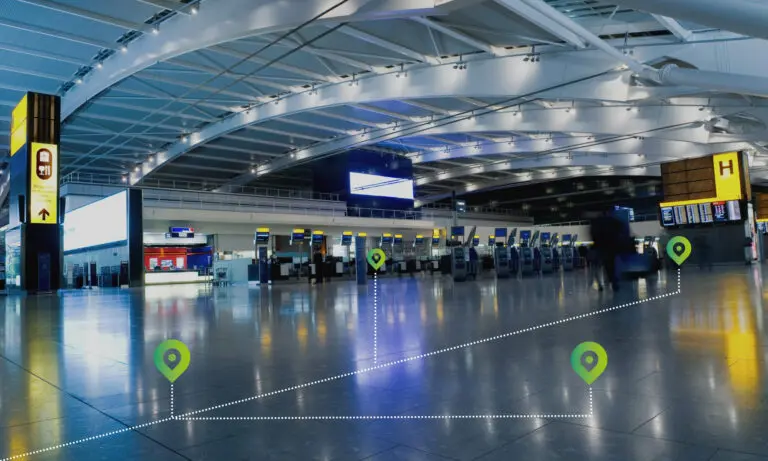10.01.2023
Why we need Indoor Location Services

“Where am I and what is the best way to get to my destination?” is a question that each of us has probably asked ourselves more than once in our lives. Again and again we search for the right way or for locations and things – especially in unknown environments. That’s why tools have been developed to help us answer this question. In the beginning, it was a simple map or an atlas that you carried with you in the car, for example, and later the navigation system or smartphone. Nowadays, we can be navigated just about anywhere. We usually use these location services automatically several times a day. Just to check how long it will take me to get to my appointment tomorrow or whether the distance is worth it for a city trip over the weekend – everyday life.
This is made possible by satellite navigation systems known as Global Navigation Satellite Systems (GNSS). The best known of these is GPS (Global Positioning System). GPS originated in the 1970s in the military. Since 2000, GPS has also been usable for the civilian population and offers a positioning accuracy of approx. 10 m in outdoor areas. While analog street maps were still the order of the day in the 1970s, life without GPS in various devices and applications is virtually unthinkable today.
Something like Indoor GPS
GPS has revolutionized and commercialized the way we perceive our physical environment and the way we use positioning. The only issue is that GPS is a positioning technology designed for outdoor environments. However, people spend most of their time indoors. In fact, statistics suggest that about 90% of our time is spent at home, in the office, in the workshop, in the hospital, gym, shopping mall, restaurant, etc.
The added value that location-based services bring us outdoors now needs to be brought indoors. This is because indoor positioning can fundamentally change the way we perceive indoor spaces in the future and offer considerable added value. According to a study by MarketsAndMarkets in 2022, the market for indoor positioning will be worth USD 24 trillion by 2027, with a compound annual growth rate (CAGR) of 22.4%.
Indoor positioning with Bluetooth
With GPS being particularly suitable for outdoor positioning, it is up to other technologies to bring this added value of positioning technology indoors as well. In recent years, numerous technologies have already been developed for indoor positioning, for example Bluetooth Low Energy (BLE), Ultra-wideband (UWB) or WiFi.
In particular, the positioning solutions that can be implemented indoors with BLE are strongly reminiscent of the advantages of GPS-based location. Within an indoor space, a user’s smartphone or other Bluetooth-enabled device can locate itself within a beacon infrastructure. In other words, the smartphone calculates its position based on signals from fixed anchor points it receives. This type of indoor positioning (IPS) is quite typical for indoor navigation use cases.
For example, a soccer fan visiting a stadium can use his or her own smartphone to be conveniently navigated via app to his or her block, the nearest kiosk or the fanshop. The scenario can also be easily applied to cruise ships, museums, large building complexes, airports, train stations and hospitals. And it’s not just about finding the right way. It is much more about perceiving unknown environments more intensively: Discovering offers, places and opportunities that one might have overlooked without value-added positioning. At the same time, in other contexts, it is primarily about additional safety through indoor positioning systems: In the case of automated guided vehicles or robots in an industrial environment, for example, positioning via Bluetooth makes an important contribution to avoiding collisions or other accidents.
The situation is similar when searching for things inside buildings. The larger and more complex a building is, the longer the walking distances and the more time-consuming and exhausting the search. With asset tracking via Bluetooth, there is also a solution for this. In contrast to the client-side approach described above, in which the user’s device calculates the position, a server-side position calculation is used here. The infrastructure is therefore not 1 by 1 comparable with that of GPS. However, it offers at least as much added value!
Advantages of Bluetooth for indoor positioning
The most decisive point of IPS with Bluetooth are certainly the parallelisms in the structural design to GPS. In addition, the following points are still of great importance:
- Almost every smartphone is Bluetooth capable. On top of that, newer Bluetooth devices offer the possibility to locate themselves indoors by using current chips. This means low hurdles for all users and devices to be able to locate themselves indoors quickly and without additional hardware (costs).
- BLE is a technology that is very scalable. Especially in the case of client-side positioning, the number of simultaneous users is unlimited. But also for tracking solutions, there are numerous opportunities – especially with technology and hardware agnostic solutions – to grow the system with the business.
- Bluetooth infrastructures for IPS have relatively low structural requirements, and are easy to install and maintain. On top of that, BLE in general, as the name implies, consumes relatively little energy, which is further reduced by the positioning on the user end device.